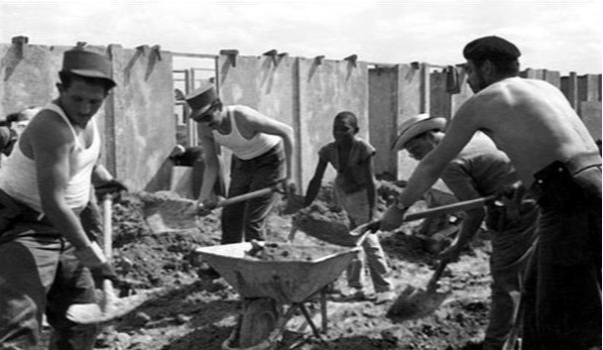
Havana, November 22 (RHC) -- What an epic day that was on November 22, 1959, when in the foothills of the Granma mountain range – in the current territory of Bartolomé Masó – a human tide overflowed the road to El Caney de Las Mercedes. There, from the collective will, the altruistic essence of voluntary work was exalted, which would mark a before and after in the already emancipated Cuba.
What a symbolic Sunday that was, in which thousands of men and women joined hands to promote the construction of the Camilo Cienfuegos School City, considered the first educational work of the Revolution, which would be destined for some 20,000 children of the Sierra Maestra.
The motivation had been born on the 22nd, when, from dawn, in Bertot Park and the Maceo Society, in Manzanillo, tobacco workers and employees of different unions, together with the shoe workers, far exceeded the capacity of the more than 40 trucks placed in that city by Commander Manuel (Piti) Fajardo Rivero – designated head of operations in the Sierra Maestra and guide of the construction of the School City – to leave for El Caney.
They say that there was so much enthusiasm to participate in that task, called by Che, that some contributed their own car, and some even rented a means of transport to get to the site where the School City was being built. Workers and peasants from other municipalities and the mountain range also arrived, in carts pulled by tractors and on horseback, willing to put their grain of sand in the work.
The Heroic Guerrilla, who had arrived in an old plane to El Caney –before the work began– climbed into the bed of a truck and explained the importance of that work day, which, although it was not the first in Cuba, would promote this type of activity, which from then on, multiplied throughout the Island.
Not in vain would it mean that "this creative work among all would revert to benefits for the people and not to enrich a boss, as before," according to what the Manzanillo native and (retired) journalist Ramón Sánchez Parra, a witness of that moment, and author of the only known photo of the epic day, told this newspaper five years ago.
Since then, in all the labor sectors of the country, voluntary work gained momentum as an expression of the collective conscience to build a greater work: the Revolution.
Today, 65 years after that dawn that became a popular celebration, the fruit of creative effort, the date reminds us that, many times, in the face of adversity, this has been a way of helping to get back on our feet; and, many times, it has served as a vital force to revive agricultural production.
Therefore, the challenge in the current scenario is to know how to motivate people, as Che taught us, by his example.

